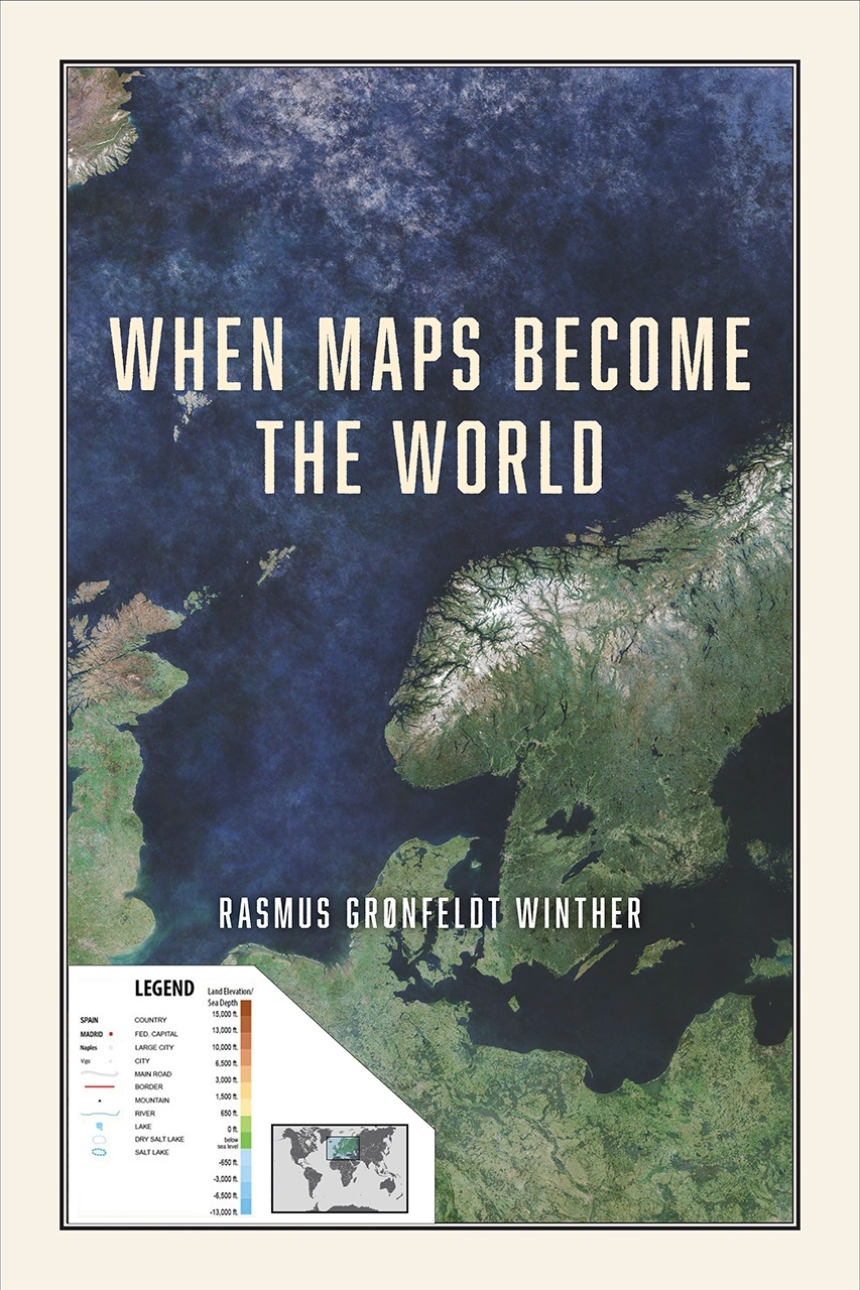When Maps Become the World
Map making and, ultimately, map thinking is ubiquitous across literature, cosmology, mathematics, psychology, and genetics. We partition, summarize, organize, and clarify our world via spatialized representations. Our maps and, more generally, our representations seduce and persuade; they build and destroy. They are the ultimate record of empires and of our evolving comprehension of our world.
This book is about the promises and perils of map thinking. Maps are purpose-driven abstractions, discarding detail to highlight only particular features of a territory. By preserving certain features at the expense of others, they can be used to reinforce a privileged position.
When Maps Become the World shows us how the scientific theories, models, and concepts we use to intervene in the world function as maps, and explores the consequences of this, both good and bad. We increasingly understand the world around us in terms of models, to the extent that we often take the models for reality. Winther explains how in time, our historical representations in science, in cartography, and in our stories about ourselves replace individual memories and become dominant social narratives—they become reality, and they can remake the world.
This book is about the promises and perils of map thinking. Maps are purpose-driven abstractions, discarding detail to highlight only particular features of a territory. By preserving certain features at the expense of others, they can be used to reinforce a privileged position.
When Maps Become the World shows us how the scientific theories, models, and concepts we use to intervene in the world function as maps, and explores the consequences of this, both good and bad. We increasingly understand the world around us in terms of models, to the extent that we often take the models for reality. Winther explains how in time, our historical representations in science, in cartography, and in our stories about ourselves replace individual memories and become dominant social narratives—they become reality, and they can remake the world.
336 pages | 10 color plates, 37 halftones | 6 x 9 | © 2020
Cognitive Science: General Works
Philosophy: General Philosophy
Physical Sciences: History and Philosophy of Physical Sciences
Reviews
Table of Contents
Preface
1. Introduction: Why Maps?
A History and Philosophy of Map Thinking
Maps Today
Three Maps
Conclusion
Part 1: Philosophy
2. Theory Is to World as Map Is to Territory
Analogy
The Map Analogy
Assumption Archaeology
Conclusion
3. From Abstraction to Ontologizing
The Abstraction-Ontologizing Account
Abstraction
Ontologizing
Conclusion
4. Long Live Contextual Objectivity!
Pernicious Reification
Contextual Objectivity
A History of the Mercator Projection I: Gerardus Mercator
A History of the Mercator Projection II: Post Mercator
Integration Platforms
Conclusion
5. Projecting Maps into Our Worlds
Two Canonical Philosophical Accounts of Representation: Isomorphism and Similarity
The Multiple Representations Account
Conclusion
Part 2: Science
6. Mapping Space
Extreme-Scale Maps in Cosmology
Literal Cartographic Maps in Geology
State-Space Maps in Physics and Physical Chemistry
Analogous Maps in Mathematics
Conclusion
7. Mapping Ourselves
Migration Maps
Brain Maps
Statistical Causal Maps
Conclusion
8. Mapping Genetics
Building a Mapping-Genetics Integration Platform
The Linear Genetic Map
The Gene Expression Map
The Genotype-Phenotype Map
The Literal Cartographic Genetic Map
The Comparative Genetic Map
The Adaptive Landscape Map
An Analogous Genetic Map: The Tree of Life
Future Extensions: Mapping Genetics as a Paradigmatic Integration Platform
9. Map Thinking Science and Philosophy
Existence, World Making, and Responsibility
Map Thinking Scientific Methodology
Map Thinking Philosophical Methodology
An Invitation to Dream
Appendix: Cognitive Map Exercise
References
Index
1. Introduction: Why Maps?
A History and Philosophy of Map Thinking
The Nature of Map Thinking—Elements of Map Thinking—Deep Mapping—Five Hundred Years of Western Mapping
Maps Today
Cartography Meets GIS—A Definition Based on Representation—Characterizations Based on Process and Function
Three Maps
Waldseemüller’s Map—Guaman Poma’s Countermap—Van Sant’s Ultimate Map?
Conclusion
Part 1: Philosophy
2. Theory Is to World as Map Is to Territory
Analogy
Three Types of Analogy—Critical Cautions
The Map Analogy
A Typology of Map Analogies—Uses of the Map Analogy in Humanistic Inquiry
Assumption Archaeology
Conclusion
3. From Abstraction to Ontologizing
The Abstraction-Ontologizing Account
Abstraction
Abstraction Stage I: Calibration of Units and Coordinates—Abstraction Stage II: Data Collection and Management—Abstraction Stage III: Generalization
Ontologizing
Ontologizing 0: Representation Testing—Ontologizing I: Changing the World—Ontologizing II: Understanding the World—Ontologizing III: Classroom Communication
Conclusion
4. Long Live Contextual Objectivity!
Pernicious Reification
Contextual Objectivity
Conformation—The Essential Indexical
A History of the Mercator Projection I: Gerardus Mercator
Mercator’s Critique of Earlier Projections—Mercator’s New Purpose: Navigation—Mercator’s Clear Presentation of Latitude and Longitude—Mercator’s Awareness of Alternative Projections
A History of the Mercator Projection II: Post Mercator
Integration Platforms
A Beyond-Mercator Integration Platform: Blocking Pernicious Reification and Seeking Contextual Objectivity—Philosophical Aspects of Integration Platforms
Conclusion
5. Projecting Maps into Our Worlds
Two Canonical Philosophical Accounts of Representation: Isomorphism and Similarity
The Isomorphism Account—The Similarity Account
The Multiple Representations Account
Ontologizing—Merely-Seeing-As—Pluralistic Ontologizing—Climate Change and Multiple Representations
Conclusion
Part 2: Science
6. Mapping Space
Extreme-Scale Maps in Cosmology
The Universe’s Baby Portrait—The Universe Growing Up (and Outward)—Cosmic-Scale Maps and the Abstraction-Ontologizing Account
Literal Cartographic Maps in Geology
State-Space Maps in Physics and Physical Chemistry
Analogous Maps in Mathematics
Conclusion
7. Mapping Ourselves
Migration Maps
Arrowized Assumptions—Arrowized Maps—Countermapping Migration
Brain Maps
Decompositional Assumptions—Phrenological Maps—The Somatosensory and Motor Homunculi—Functional Magnetic Resonance Imaging (fMRI)—Countermapping the Brain
Statistical Causal Maps
Linear Model Assumptions—Correlation and Causation—“Genetic” and “Environmental” Diseases—Path Diagrams as Statistical Causal Maps—When Causal Maps Become the World
Conclusion
8. Mapping Genetics
Building a Mapping-Genetics Integration Platform
Assumptions—Terminology—Map Types
The Linear Genetic Map
Linear Genetic Maps of Phenotypic Linkage—Linear Genetic Maps of Nucleotides—Assumptions of the Linear Genetic Map
The Gene Expression Map
The Genotype-Phenotype Map
The Literal Cartographic Genetic Map
The Comparative Genetic Map
The Adaptive Landscape Map
An Analogous Genetic Map: The Tree of Life
Darwin’s Hypothesis—Contemporary Phylogenies
Future Extensions: Mapping Genetics as a Paradigmatic Integration Platform
9. Map Thinking Science and Philosophy
Existence, World Making, and Responsibility
Map Thinking Scientific Methodology
Map Thinking Philosophical Methodology
Assumption Archaeology—Tracking Ethics and Power—Imagining “What If . . . ?”
An Invitation to Dream
Appendix: Cognitive Map Exercise
References
Index
